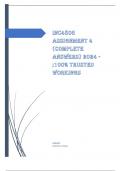ADMIN
[COMPANY NAME]
, Provide a detailed discussion of the methods you plan to use to investigate
the research problem you have identified. This assignment requires you to
convince the reader that you will carry out the investigation correctly. The
following guidelines should help you in this regard: i. Describe your chosen
research method/approach (qualitative/quantitative/mixed methods) and state
its relevance to your research problem.
Certainly! Let's outline a detailed plan for investigating your research problem using qualitative
methods.
Research Method/Approach: Qualitative
Relevance to Research Problem: Qualitative methods are particularly well-suited for exploring
complex phenomena, understanding social processes, and gaining insight into individuals'
experiences, perspectives, and behaviors. Since your research problem likely involves
understanding nuanced aspects, exploring motivations, or uncovering underlying meanings,
qualitative methods will allow us to delve deeply into these aspects.
Detailed Plan:
1. Research Design Selection:
• Choose a suitable qualitative research design such as phenomenology, ethnography,
grounded theory, or case study, depending on the nature of the research problem. Each
design offers a unique approach to understanding the phenomenon under investigation.
2. Participant Selection:
• Identify and recruit participants who possess relevant experiences, knowledge, or
perspectives related to the research problem. Utilize purposeful sampling techniques to
ensure diversity and richness in the data collected.
3. Data Collection Methods:
• Conduct semi-structured interviews, focus groups, participant observations, or use of
documents and artifacts to gather rich qualitative data. Each method offers unique
insights and perspectives, allowing for triangulation and validation of findings.
• Employ techniques such as member checking to ensure the accuracy and credibility of
the data collected.
4. Data Analysis:
• Utilize thematic analysis, content analysis, or narrative analysis to identify patterns,
themes, and insights within the collected data.
• Engage in rigorous coding processes to systematically organize and analyze the data,
ensuring that no relevant information is overlooked.
• Maintain reflexivity throughout the analysis process to acknowledge and address any
biases or preconceptions that may influence interpretations.
5. Trustworthiness and Validity:




